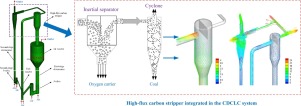Particuology ( IF 4.1 ) Pub Date : 2019-07-02 , DOI: 10.1016/j.partic.2019.04.004 Xiaojia Wang , Yali Shao , Baosheng Jin , Yong Zhang

|
Coal-direct chemical-looping combustion (CDCLC) is a promising coal combustion technique that provides CO2 capture with a low energy penalty. In this study, we developed a three-dimensional Eulerian–Eulerian multiphase full-loop model for simulating the circulation and separation of binary particle mixtures in a novel high-flux CDCLC system. This model comprised a high-flux circulating fluidized bed as the fuel reactor (FR), a counter-flow moving bed as the air reactor (AR), a high-flux carbon stripper, two downcomers, and two J-valves. This model predicted the main features of complex gas–solid flow behaviors in the system. The simulation results showed that quasi-stable solid circulation in the whole system could be achieved, and the FR, AR, and J-valves operated in a dense suspension upflow regime, a near-plug-flow regime, and a bubbling fluidization regime, respectively. The multiphase flow model of binary particle mixtures was used to predict the mechanisms of directional separation of binary particle mixtures of an oxygen carrier (OC) and coal throughout the system. A decrease in the baffle aspect ratio of the inertial separator improved the coal selective separation efficiency but resulted in a slight decline in the OC selective separation; this is believed to be the result of weakening of particle collisions with the baffle. A higher FR gas velocity had a slightly negative effect on the OC selective separation efficiency, but improved the coal selective separation efficiency; this can be attributed to an increase in the particle-carrying capacity of the gas stream. A decrease in the coal particle size led to better entrainment of the coal particles by the gas stream and this increased the coal selective separation efficiency. In real CDCLC applications, the operating variables for separation of binary particle mixtures should be comprehensively assessed to determine their positive and negative effects on the carbon capture efficiency, OC regeneration efficiency, gas leakage restraint, energy consumption, and fuel conversion.
中文翻译:

高通量煤直接化学循环燃烧系统中二元颗粒混合物定向分离的三维多相全回路模拟
煤直接化学循环燃烧(CDCLC)是一种有前途的煤燃烧技术,可提供CO 2能量消耗低的捕获。在这项研究中,我们开发了一个三维欧拉-欧拉多相全回路模型,用于模拟新型高通量CDCLC系统中二元颗粒混合物的循环和分离。该模型包括作为燃料反应器(FR)的高通量循环流化床,作为空气反应器(AR)的逆流移动床,高通量碳汽提塔,两个降液管和两个J阀。该模型预测了系统中复杂的气固流行为的主要特征。模拟结果表明,可以实现整个系统的准稳定固相循环,并且FR,AR和J阀在密悬液上流状态,近塞流状态和鼓泡流化状态下运行,分别。使用二元颗粒混合物的多相流模型来预测整个系统中氧载体(OC)和煤的二元颗粒混合物的定向分离机理。惯性分离器折流板长径比的降低提高了煤的选择性分离效率,但导致OC选择性分离略有下降。据信这是减弱了与挡板的颗粒碰撞的结果。较高的FR气体速度对OC的选择性分离效率有轻微的负面影响,但提高了煤的选择性分离效率。这可以归因于气流的颗粒携带能力的增加。煤颗粒尺寸的减小导致气流更好地夹带煤颗粒,并且这提高了煤的选择性分离效率。在实际的CDCLC应用中,应综合评估用于分离二元颗粒混合物的操作变量,以确定它们对碳捕获效率,OC再生效率,气体泄漏抑制,能量消耗和燃料转化的正面和负面影响。











































 京公网安备 11010802027423号
京公网安备 11010802027423号